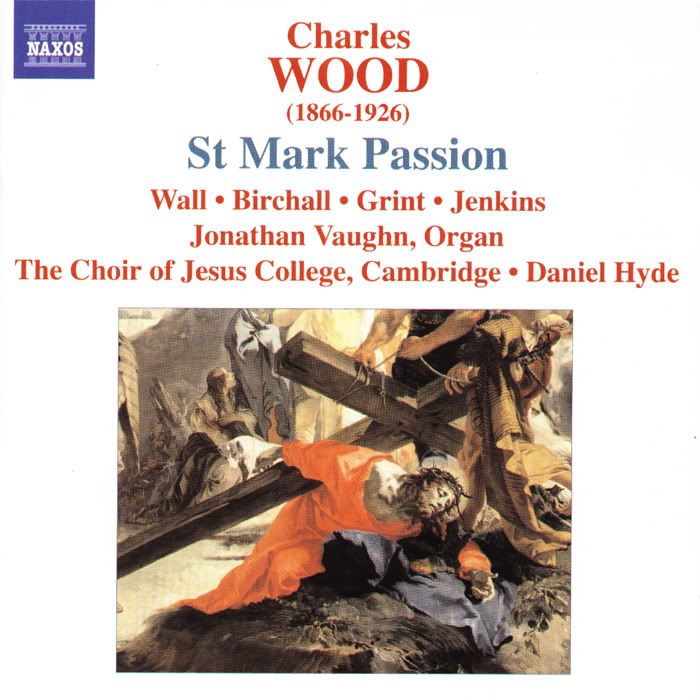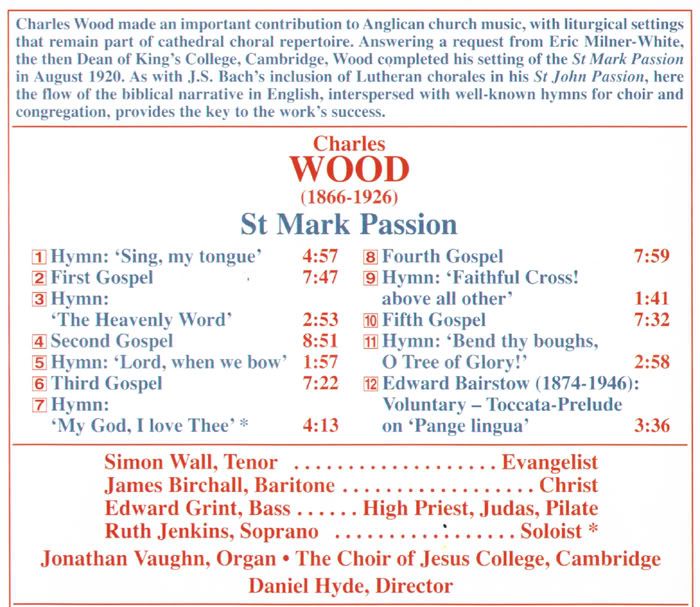 |
| NetLab · Rules · Torrent Tracker · Have a problem? · Eng/Rus |
 Help Help
 Search Search
 Members Members
 Gallery Gallery
 Calendar Calendar
|
| Welcome Guest ( Log In | Register | Validation ) | Resend Validation Email |
|
Posted: 10-05-2009, 22:08
(post 1, #893820)
|
||||||||||||||||||
|
Pro Member Group: Members Posts: 695 Warn:0% |
Charles Wood (1866 - 1926) Sir Edward Bairstow (1874 - 1946) St. Mark Passion Label: Naxos, 8.570561 Year: 2008 Performers: Wood James Birchall - baritone Simon Wall - tenor Nicola Hands - soprano Ruth Jenkins - soprano David Barron - alto Edward Grint - bass Jonathan Vaughn - organ The Choir of Jesus College, Cambridge Daniel Hyde - conductor Tracklist: 01. Hymn: Sing, my tongue, the glorious battle 02. First Gospel: And the first day of unleavened bread 03. Hymn: The Heavenly Word proceeding forth 04. Second Gospel: And they came to a place which was named Gethsemane 05. Hymn: Lord, when we bow before Thy Throne 06. Third Gospel: And they led Jesus away to the high priests 07. Hymn: My God, I love Thee 08. Fourth Gospel: And straightway in the morning 09. Hymn: Faithful Cross! Above all other 10. Fifth Gospel: And they bring Him into the place Golgotha 11. Hymn: Bend thy boughs, O Tree of Glory! Sir Edward Bairstow 12. Toccata - Prelude on Pange Lingua Naxos have released a setting of the St. Mark Passion from the Irish-born composer Charles Wood; a pupil of Stanford and Parry at the Royal College of Music (RCM). Also included on this attractive release is a short organ voluntary from Sir Edward Bairstow. The inspired choice of the Choir of Jesus College under the direction of Daniel Hyde, singing the music of Charles Wood in the chapel of St. John’s College Chapel maintains the strong Cambridge connection. Charles Wood made an important contribution to Anglican church music, with liturgical settings that remain part of cathedral choral repertoire. Answering a request from Eric Milner-White, the then Dean of King’s College, Cambridge, Wood completed his setting of the St Mark Passion in August 1920. As with J.S. Bach’s inclusion of Lutheran chorales in his St John Passion, here the flow of the biblical narrative in English, interspersed with well-known hymns for choir and congregation, provides the key to the work’s success. Charles Wood’s St. Mark Passion might be said to spring from the same well as such pieces as Stainer’s Crucifixion (1887) or Maunder’s Olivet to Calvary (1904). These works, of which Stainer’s is by a long way the best, were produced to give Victorian parish choirs of a reasonable standard music with which they could mark Holy Week. Commonly such pieces would incorporate hymns as a way of involving the congregations in much the same way that the chorales function in Bach’s Passion settings. Wood’s work, which was composed in 1920, was written at the behest of Eric Milner-White (1884-1963), a remarkable Anglican cleric who, at that time, was Dean of King’s College, Cambridge, a post that he held from the end of Word War I until 1941, when he became Dean of York Minster. Milner-White had a strong interest in the role of music in the liturgy – it was he who instituted the Festival of Nine Lessons and Carols at King’s – and, as Daniel Hyde points out in his useful booklet note, he decided to invite Wood to compose this Passion setting because he felt that parochial choirs needed at least to have an alternative to Stainer et al. Wood’s setting of the Passion was first sung in King’s College Chapel, by the college choir under A H Mann, on Good Friday 1921. Wood was an obvious person to turn to for this assignment as he had impeccable credentials in the field of church music at the time and he was a Cambridge man through and through; he occupied various posts in the University from 1888 onwards, finally succeeding his old teacher, Stanford, as Professor of Music in 1924. The structure of the work is straightforward. St. Mark’s narrative is divided into five sections or Gospels during which the story is told sometimes by the choir and sometimes by the tenor Evangelist. The first Gospel deals with the Last Supper; Gospel II with Gethsemane; Peter’s denial is related in Gospel III; while Gospel IV tells of Christ’s appearance before Pilate and Gospel V describes the crucifixion itself. In between these Gospels, and at the very beginning and end, the choir sing appropriate hymns. I didn’t have access to a score so I don’t know if Daniel Hyde has cut out some verses from the hymns but in this performance the most that we hear in any hymn is four verses. This brevity on the part of Wood or Hyde is welcome for in Stainer’s Crucifixion, for example, some of the hymns do tend to outstay their welcome. Wood’s setting differs from the aforementioned works by Maunder and Stainer in that he does not include any solo arias; apart from the hymns all that we get is narrative. Also he doesn’t give the choir any oratorio-style choruses. I welcome this because in Crucifixion the choruses are, frankly, the weakest sections of the work by some distance while Olivet to Calvary is even worse in this respect – and is a much inferior piece to the Stainer, in any event. So in some respects Wood’s work could be regarded as somewhat austere; there is nothing showy about the writing though the organ part is sometimes appropriately descriptive. However, Wood is not dull or foursquare in his choral writing and the work has a freshness and, above all, a sincerity that I found impressive. It helps, I’m sure, that the performance is a good one. Simon Wall has a light, clear and flexible voice, which he uses intelligently and effectively. His narration is involving yet has just the right degree of restraint. James Birchall is just as good in the role of Christ, singing with appropriate dignity. Edward Grint has much less to do but he sings his brief solos satisfactorily. The choir is excellent. They sing with an appealing youthful freshness yet there’s body in the tone as well. The voices are well blended and tuning and diction are very good. When Wood requires them to be vigorous or dramatic they respond very well but it’s their quieter singing that impresses particularly. Thus, the Fifth Gospel, which is unaccompanied throughout, is very sensitively sung. I’d also single out for special praise the way they sing the hymn, ‘My God I love Thee’ after the Third Gospel. The singing here is dedicated and the final verse is distinguished by radiantly pure solo soprano descant, which Ruth Jenkins delivers quite beautifully. Daniel Hyde has clearly trained his young choir splendidly and he and they perform Wood’s piece with conviction.   LOG
This post has been edited by kgkk on 10-05-2009, 22:11 |
||||||||||||||||||
|
|||||||||||||||||||
|
Posted: 24-05-2009, 11:59
(post 2, #896170)
|
||
|
Newbie Group: Members Posts: 4 Warn:0% |
Can anybody share it in emule or magnet, please? Thanks! |
||
|
Posted: 13-06-2009, 16:27
(post 3, #899130)
|
||
|
Newbie Group: Members Posts: 2 Warn:0% |
|
||


Powered by Invision Power Board v1.3.1 Final.

